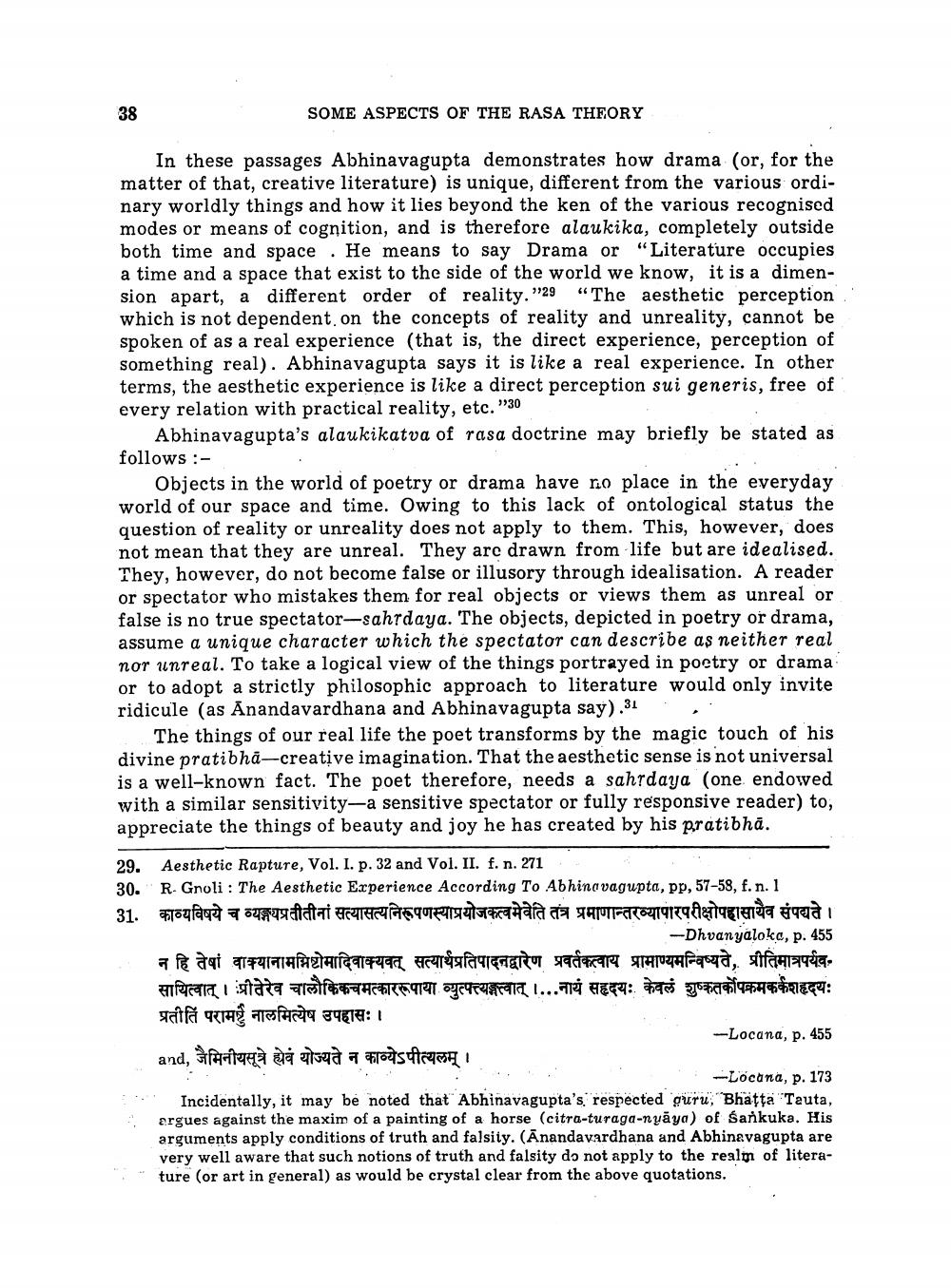________________
38
SOME ASPECTS OF THE RASA THEORY
In these passages Abhinavagupta demonstrates how drama (or, for the matter of that, creative literature) is unique, different from the various ordinary worldly things and how it lies beyond the ken of the various recognised modes or means of cognition, and is therefore alaukika, completely outside both time and space . He means to say Drama or “Literature occupies a time and a space that exist to the side of the world we know, it is a dimension apart, a different order of reality."29 "The aesthetic perception which is not dependent on the concepts of reality and unreality, cannot be spoken of as a real experience (that is, the direct experience, perception of something real). Abhinavagupta says it is like a real experience. In other terms, the aesthetic experience is like a direct perception sui generis, free of every relation with practical reality, etc. "30
Abhinavagupta's alaukikatva of rasa doctrine may briefly be stated as follows:
Objects in the world of poetry or drama have no place in the everyday world of our space and time. Owing to this lack of ontological status the question of reality or unreality does not apply to them. This, however, does not mean that they are unreal. They are drawn from life but are idealised. They, however, do not become false or illusory through idealisation. A reader or spectator who mistakes them for real objects or views them as unreal or false is no true spectator-sahrdaya. The objects, depicted in poetry or drama, assume a unique character which the spectator can describe as neither real nor unreal. To take a logical view of the things portrayed in poetry or drama or to adopt a strictly philosophic approach to literature would only invite ridicule (as Anandavardhana and Abhinavagupta say).31.
The things of our real life the poet transforms by the magic touch of his divine pratibha-creative imagination. That the aesthetic sense is not universal is a well-known fact. The poet therefore, needs a sahrdaya (one endowed with a similar sensitivity-a sensitive spectator or fully responsive reader) to, appreciate the things of beauty and joy he has created by his pratibha.
29. Aesthetic Rapture, Vol. I. p.32 and Vol. II. f. n. 271 30. R. Gnoli : The Aesthetic Experience According to Abhinavagupta, pp, 57-58, f. n. 1 31. काव्यविषये च व्यङ्गयप्रतीतीनां सत्यासत्यनिरूपणस्याप्रयोजकत्वमेवेति तंत्र प्रमाणान्तरव्यापारपरीक्षोपहासायैव संपद्यते।
--Dhvanyaloko, p. 455 न हि तेषां वाक्यानामग्निष्टोमादिवाक्यवत् सत्यार्थप्रतिपादनद्वारेण प्रवर्तकत्वाय प्रामाण्यमन्विष्यते, प्रीतिमात्रपर्यव. सायित्वात् । प्रीतेरेव चालौकिकचमत्काररूपाया व्युत्पत्यजत्वात् ।...नायं सहृदयः केवलं शुष्कतर्कोपक्रमकर्कशहृदयः प्रतीति परामष्टुं नालमित्येष उपहासः।
-Locana, p. 455 and, shitene i loga a FrostS
-Locana, p. 173 Incidentally, it may be noted that Abhinavagupta's respected guru, Bhatta Tauta, argues against the maxim of a painting of a horse (citra-turaga-nyāya) of Sankuka. His arguments apply conditions of truth and falsiiy. (Anandavardhana and Abhinavagupta are very well aware that such notions of truth and falsity do not apply to the realm of literature (or art in general) as would be crystal clear from the above quotations.




